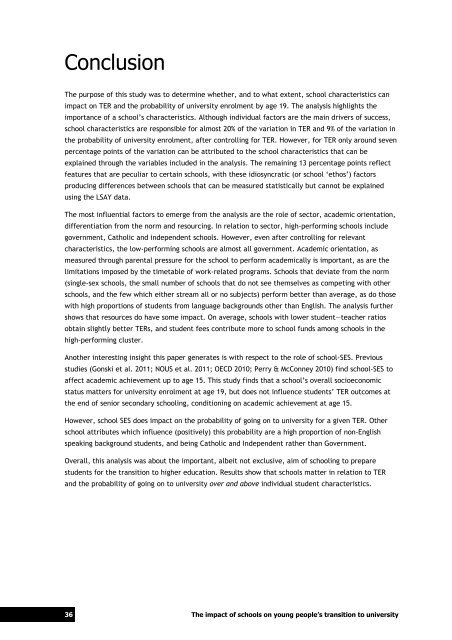The impact of schools on young people's transition to university
The impact of schools on young people's transition to university
The impact of schools on young people's transition to university
Create successful ePaper yourself
Turn your PDF publications into a flip-book with our unique Google optimized e-Paper software.
C<strong>on</strong>clusi<strong>on</strong><br />
<str<strong>on</strong>g>The</str<strong>on</strong>g> purpose <str<strong>on</strong>g>of</str<strong>on</strong>g> this study was <strong>to</strong> determine whether, and <strong>to</strong> what extent, school characteristics can<br />
<str<strong>on</strong>g>impact</str<strong>on</strong>g> <strong>on</strong> TER and the probability <str<strong>on</strong>g>of</str<strong>on</strong>g> <strong>university</strong> enrolment by age 19. <str<strong>on</strong>g>The</str<strong>on</strong>g> analysis highlights the<br />
importance <str<strong>on</strong>g>of</str<strong>on</strong>g> a school’s characteristics. Although individual fac<strong>to</strong>rs are the main drivers <str<strong>on</strong>g>of</str<strong>on</strong>g> success,<br />
school characteristics are resp<strong>on</strong>sible for almost 20% <str<strong>on</strong>g>of</str<strong>on</strong>g> the variati<strong>on</strong> in TER and 9% <str<strong>on</strong>g>of</str<strong>on</strong>g> the variati<strong>on</strong> in<br />
the probability <str<strong>on</strong>g>of</str<strong>on</strong>g> <strong>university</strong> enrolment, after c<strong>on</strong>trolling for TER. However, for TER <strong>on</strong>ly around seven<br />
percentage points <str<strong>on</strong>g>of</str<strong>on</strong>g> the variati<strong>on</strong> can be attributed <strong>to</strong> the school characteristics that can be<br />
explained through the variables included in the analysis. <str<strong>on</strong>g>The</str<strong>on</strong>g> remaining 13 percentage points reflect<br />
features that are peculiar <strong>to</strong> certain <str<strong>on</strong>g>schools</str<strong>on</strong>g>, with these idiosyncratic (or school ‘ethos’) fac<strong>to</strong>rs<br />
producing differences between <str<strong>on</strong>g>schools</str<strong>on</strong>g> that can be measured statistically but cannot be explained<br />
using the LSAY data.<br />
<str<strong>on</strong>g>The</str<strong>on</strong>g> most influential fac<strong>to</strong>rs <strong>to</strong> emerge from the analysis are the role <str<strong>on</strong>g>of</str<strong>on</strong>g> sec<strong>to</strong>r, academic orientati<strong>on</strong>,<br />
differentiati<strong>on</strong> from the norm and resourcing. In relati<strong>on</strong> <strong>to</strong> sec<strong>to</strong>r, high-performing <str<strong>on</strong>g>schools</str<strong>on</strong>g> include<br />
government, Catholic and independent <str<strong>on</strong>g>schools</str<strong>on</strong>g>. However, even after c<strong>on</strong>trolling for relevant<br />
characteristics, the low-performing <str<strong>on</strong>g>schools</str<strong>on</strong>g> are almost all government. Academic orientati<strong>on</strong>, as<br />
measured through parental pressure for the school <strong>to</strong> perform academically is important, as are the<br />
limitati<strong>on</strong>s imposed by the timetable <str<strong>on</strong>g>of</str<strong>on</strong>g> work-related programs. Schools that deviate from the norm<br />
(single-sex <str<strong>on</strong>g>schools</str<strong>on</strong>g>, the small number <str<strong>on</strong>g>of</str<strong>on</strong>g> <str<strong>on</strong>g>schools</str<strong>on</strong>g> that do not see themselves as competing with other<br />
<str<strong>on</strong>g>schools</str<strong>on</strong>g>, and the few which either stream all or no subjects) perform better than average, as do those<br />
with high proporti<strong>on</strong>s <str<strong>on</strong>g>of</str<strong>on</strong>g> students from language backgrounds other than English. <str<strong>on</strong>g>The</str<strong>on</strong>g> analysis further<br />
shows that resources do have some <str<strong>on</strong>g>impact</str<strong>on</strong>g>. On average, <str<strong>on</strong>g>schools</str<strong>on</strong>g> with lower student—teacher ratios<br />
obtain slightly better TERs, and student fees c<strong>on</strong>tribute more <strong>to</strong> school funds am<strong>on</strong>g <str<strong>on</strong>g>schools</str<strong>on</strong>g> in the<br />
high-performing cluster.<br />
Another interesting insight this paper generates is with respect <strong>to</strong> the role <str<strong>on</strong>g>of</str<strong>on</strong>g> school-SES. Previous<br />
studies (G<strong>on</strong>ski et al. 2011; NOUS et al. 2011; OECD 2010; Perry & McC<strong>on</strong>ney 2010) find school-SES <strong>to</strong><br />
affect academic achievement up <strong>to</strong> age 15. This study finds that a school’s overall socioec<strong>on</strong>omic<br />
status matters for <strong>university</strong> enrolment at age 19, but does not influence students’ TER outcomes at<br />
the end <str<strong>on</strong>g>of</str<strong>on</strong>g> senior sec<strong>on</strong>dary schooling, c<strong>on</strong>diti<strong>on</strong>ing <strong>on</strong> academic achievement at age 15.<br />
However, school SES does <str<strong>on</strong>g>impact</str<strong>on</strong>g> <strong>on</strong> the probability <str<strong>on</strong>g>of</str<strong>on</strong>g> going <strong>on</strong> <strong>to</strong> <strong>university</strong> for a given TER. Other<br />
school attributes which influence (positively) this probability are a high proporti<strong>on</strong> <str<strong>on</strong>g>of</str<strong>on</strong>g> n<strong>on</strong>-English<br />
speaking background students, and being Catholic and Independent rather than Government.<br />
Overall, this analysis was about the important, albeit not exclusive, aim <str<strong>on</strong>g>of</str<strong>on</strong>g> schooling <strong>to</strong> prepare<br />
students for the transiti<strong>on</strong> <strong>to</strong> higher educati<strong>on</strong>. Results show that <str<strong>on</strong>g>schools</str<strong>on</strong>g> matter in relati<strong>on</strong> <strong>to</strong> TER<br />
and the probability <str<strong>on</strong>g>of</str<strong>on</strong>g> going <strong>on</strong> <strong>to</strong> <strong>university</strong> over and above individual student characteristics.<br />
36 <str<strong>on</strong>g>The</str<strong>on</strong>g> <str<strong>on</strong>g>impact</str<strong>on</strong>g> <str<strong>on</strong>g>of</str<strong>on</strong>g> <str<strong>on</strong>g>schools</str<strong>on</strong>g> <strong>on</strong> <strong>young</strong> people’s transiti<strong>on</strong> <strong>to</strong> <strong>university</strong>


